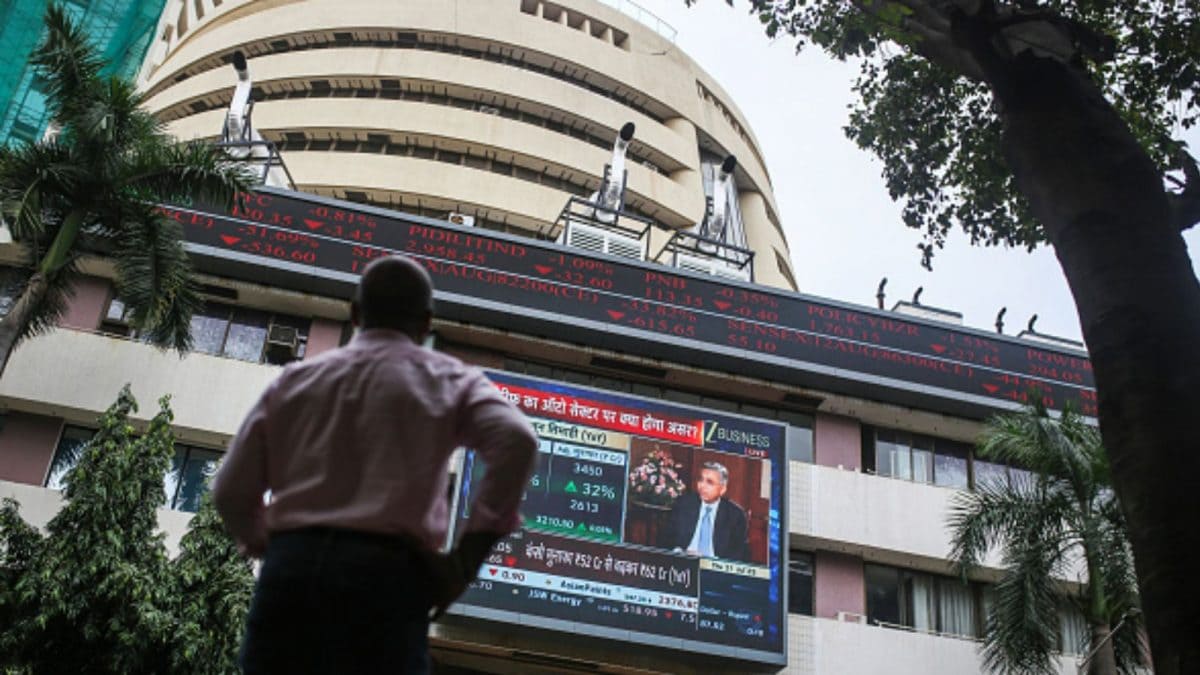Business
Tesco not ‘losing grip’ on UK grocery market despite persistent price war

Tesco is showing no signs of “losing its grip” as the UK’s biggest supermarket – despite battling an persistent price war and a plethora of higher business costs, experts say.
Investors will be hoping the grocery giant is maintaining sales growth when it publishes its half-year financial results on Thursday.
Tesco revealed its group sales rose by 4.6% in its first quarter, compared with the prior year, having been boosted by growing demand for own-brand and premium products.
It has been steadily growing its share of the UK grocery market – picking up 0.8 percentage points over the past year to 28.4%, according to the latest analysis by Worldpanel by Numerator.
Meanwhile, its biggest rivals Sainsbury’s and Asda have seen their share of the market edge lower, while German discounters Aldi and Lidl continue to gain customers.
Tesco’s shares have soared to their highest price in more than a decade amid the strengthening performance.
Richard Hunter, head of markets for Interactive Investor, said: “Expectations will be high as ever for the supermarket, although at the first quarter numbers in June there were no signs that the company was losing its grip on dominating the British aisles.
“Indeed, the juggernaut powered on, maintaining the light between the group and its nearest rivals.”
However, Tesco’s boss Ken Murphy acknowledged at the company’s most recent trading update that the grocery market was “intensely competitive”.
It comes amid continued pressure on pricing from rival supermarkets, with Asda slashing prices this year in a bid to help turn around its fortunes.
In April, Tesco said it expects to make as much as £400 million less in profit this financial year due to heightened competition.
Mr Hunter said the prospect of a grocery price war was “not one which Tesco is taking lightly, and is mindful of a renewed attack from Asda”.
He added that any updates to its annual profit forecast on Thursday would be “warmly received” by shareholders.
A group of analysts for AJ Bell said the grocery price war is expected to impact profits, but that Tesco was also experiencing “input cost pressure, notably wages, national insurance contributions and food prices”.
It is among major retailers to back calls to the Government to limit further tax rises on the industry, as they warn it is becoming increasingly difficult to “absorb” higher costs.
It comes amid concerns about food inflation, which has been accelerating for five months in a row.
Business
Pine Labs IPO Day 3: Issue Gets 2.48x Subscription, Retail Quota Booked 1.27x; GMP At Zero

Pine Labs IPO Day 3 GMP, Subscription Status, Price, Allotment & Listing Date: Fintech firm Pine Labs witnessed the last day of its Rs 3,899.91-crore initial public offering (IPO). The IPO, whose price was fixed at Rs 210-221 apiece, has been today, November 11, at 5 pm. The IPO received a 2.48x subscription on Day 3, 13 per cent subscription on the first day of bidding on Friday and 55 per cent on Day 2 on Monday.
However, its grey market premium has further fallen to nil, compared with 1.81% on Monday.
The company raised Rs 1,754 crore from anchor investors on Thursday, a day before the IPO.
The anchor book saw participation from 71 funds, including Franklin Templeton, Nomura, Morgan Stanley Asia Singapore Pte Ltd, Amundi Funds New Silk Road, Massachusetts Institute of Technology, BNP Paribas and Eastspring Investments, according to a circular uploaded on BSE’s website.
Pine Labs IPO GMP Today
According to market observers, unlisted shares of Pine Labs are currently trading at Rs 221 apiece in the grey market, which is zero premium (or GMP) over the upper IPO price of Rs 221, indicating flat or negative listing for the company.
The GMP was Rs 5.43% on Friday and nearly 16% a few days ago.
The GMP is based on market sentiments and keeps changing. ‘Grey market premium’ indicates investors’ readiness to pay more than the issue price.
Pine Labs IPO: Opening, Closing, Allotment, Listing Dates
The IPO was opened on November 7 and will be closed on November 11. Its allotment will be finalised on November 12, while the stock listing is scheduled to take place on November 14 on both BSE and NSE.
Pine Labs IPO: Should You Apply?
Brokerages have given a mixed response to the Pine Labs IPO, with views split between long-term optimism and near-term caution. While some see strong potential in its business model, others find the valuation steep given its loss-making status.
Cautious Voices
Arihant Capital advised investors to avoid the issue, citing losses at the PAT level and high employee and technology costs. Swastika Investmart also suggested avoiding the IPO for now, calling it “aggressively valued” with limited short-term visibility. Angel One rated it neutral, noting that the company remains loss-making and trades at a premium to peers on an EV/EBITDA basis, while warning of risks like regulatory uncertainty and intense competition.
Long-Term Optimism
On the other hand, SBI Securities gave a ‘subscribe for long-term’ rating, citing Pine Labs’ strong network of 9.8 lakh merchants and Rs 276 trillion market opportunity by FY29. It said the firm is well placed to deliver profitable growth. IDBI Capital also recommended ‘subscribe for long-term’, highlighting Pine Labs’ Rs 11,424.97 billion transaction volume in FY25 and its strategic acquisitions that strengthen its digital infrastructure ecosystem.
Business
Sensex Ends 336 Points Higher, Nifty Above 25,700; IT Shares Shine

Last Updated:
Indian equity benchmark indices, Sensex and Nifty, are expected to open higher on Tuesday, tracking strong global cues.
Indian equity markets
Benchmark equity indices staged a strong rebound on Tuesday, closing higher on the back of solid gains in IT and auto stocks.
The BSE Sensex recovered 747 points from the day’s low of 83,124.03 to settle at 83,871.32, up 335.97 points or 0.40 per cent. Similarly, the Nifty50 climbed 120.6 points, or 0.47 per cent, to end at 25,694.95 after bouncing back 245.7 points from its intraday low of 25,449.25.
On the BSE, Bharat Electronics (BEL), Adani Ports and Mahindra & Mahindra (M&M) emerged as the top gainers, while Bajaj Finance, Bajaj Finserv and Tata Motors PV were among the biggest drags.
Across the NSE, IndiGo, BEL and M&M led the gainers’ pack, whereas Bajaj Finance, Bajaj Finserv and ONGC were the top losers.
Broader markets ended mixed — the Nifty Midcap 100 gained 0.50 per cent, while the Smallcap index slipped 0.21 per cent.
Sectorally, Nifty IT and Auto were the best performers, advancing 1.20 per cent and 1.07 per cent, respectively. On the other hand, Nifty PSU Bank was the only notable laggard, slipping 0.39 per cent.
Among sectoral indices, Nifty Financial Services fell 0.7%, and Nifty PSU Bank declined 0.5%, dragging the overall market sentiment.
Global Cues
Global sentiment improved after US President Donald Trump said his administration is working on “a very different deal” with India compared with past negotiations. “They don’t love me, but they will love us again. We are getting a fair deal — just a fair deal,” Trump said on Monday.
Across Asia, markets advanced following Wall Street’s strong overnight rally. Japan’s Nikkei 225 gained 0.56%, South Korea’s KOSPI rose 2.24%, and Hong Kong’s Hang Seng was up 0.4%.
In the U.S., equities surged on Monday, led by AI-heavyweights Nvidia and Palantir, as optimism grew over progress toward ending the record U.S. government shutdown. The S&P 500 climbed 1.54%, the Nasdaq Composite jumped 2.27%, and the Dow Jones Industrial Average added 0.81%.

Aparna Deb is a Subeditor and writes for the business vertical of News18.com. She has a nose for news that matters. She is inquisitive and curious about things. Among other things, financial markets, economy, a…Read More
Aparna Deb is a Subeditor and writes for the business vertical of News18.com. She has a nose for news that matters. She is inquisitive and curious about things. Among other things, financial markets, economy, a… Read More
November 11, 2025, 09:13 IST
Read More
Business
Unemployment rate hits highest outside Covid years for almost a decade

The UK’s jobless rate has hit its highest level outside the pandemic era for nearly a decade as experts said the further evidence of a weakened labour market made a year-end interest rate cut more likely.
Official figures showed the rate of unemployment surged to 5% in the three months to September, up from 4.8% in the three months to August.
The Office for National Statistics (ONS) said that, with the skewed levels seen during the Covid-19 years stripped out, this was the highest seen since August 2016.
The ONS said average regular wage growth also pulled back again, to 4.6% in the three months to September, down from 4.7% in the previous three months.
Experts said the weaker-than-expected figures reinforced the case for the Bank of England to cut interest rates next month.
Martin Beck, chief economist at WPI Strategy, said: “With pay growth slowing further, the data strengthen the case for the Bank of England to cut interest rates next month.”
He warned that the “prospect of new tax rises in the upcoming Budget poses further risks to employment, particularly if the Chancellor again looks to raise taxes on businesses”.
Mr Beck added: “But this time, Rachel Reeves is more likely to target earners rather than employers.”
The pound slipped back, down 0.4% to 1.313 US dollars and 0.4% lower at 1.135 euros, as financial markets increasingly bet on a year-end rate cut.
The ONS said earnings are still outstripping inflation, although by a smaller margin, with real wages 0.8% higher after taking Consumer Prices Index (CPI) inflation into account, down from 0.9% in the previous three months.
In further evidence of a tough jobs market, the ONS estimated the number of workers on UK payrolls fell by 32,000 during October to 30.3 million, following an upwardly revised 32,000 drop the previous month, although the numbers are subject to further revisions.
This was the largest two-month drop since late 2020, economists said.
ONS director of economic statistics Liz McKeown said: “Taken together these figures point to a weakening labour market.
“The number of people on payroll is falling, with revised tax data now showing falls in most of the last 12 months.”
There was one bright spot in the data, with vacancies rising for the first time in more than three years – estimated to be up by 2,000, or 0.2%, to 723,000 in the three months to October.
Mr Beck said the sharp drop in payrolls data pointed to caution among businesses ahead of the November 26 Budget.
“Signs of renewed weakness in the UK labour market suggest the real economy is starting to feel the chill of Budget tax uncertainty,” he said.
Investec Economics said the jobs data and easing in wage growth – both of which are being watched carefully by the Bank of England – made a December cut in rates from 4% to 3.75% more likely.
“What will be key however to the December debate, and the path for rates looking further forward, are the two CPI reports, and of course the details of the Budget, which we will receive before the December 18 rate announcement,” said Investec economist Ellie Henderson.
James White, at EY Item Club, said the figures, and slowing in private sector pay growth to 4.2% in the three months to September, removes “one potential roadblock to a pre-Christmas rate cut”, and also boosts the chances of “further rate cuts in 2026”.
-

 Sports1 week ago
Sports1 week agoPakistani runners make their mark at Istanbul Marathon
-

 Tech1 week ago
Tech1 week agoLive TV Isn’t Dead. These Are the Best Live TV Streaming Services
-

 Entertainment1 week ago
Entertainment1 week agoPresident Zardari to attend Second World Summit for Social Development in Doha
-

 Politics1 week ago
Politics1 week agoIran vows to rebuild nuclear sites ‘stronger than before’
-

 Entertainment1 week ago
Entertainment1 week agoGeorge Clooney on “Jay Kelly,” fame and family
-

 Sports1 week ago
Sports1 week agoTransfer rumors, news: Man United eye loan deal for Real Madrid’s Endrick
-

 Tech1 week ago
Tech1 week agoCISOs in court: Balancing cyber resilience and legal accountability | Computer Weekly
-
Sports1 week ago
Lamar Jackson, the point spread and the perils of NFL injury reporting





